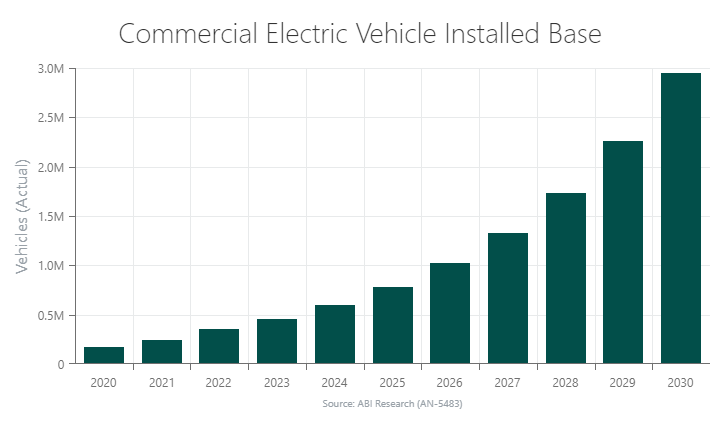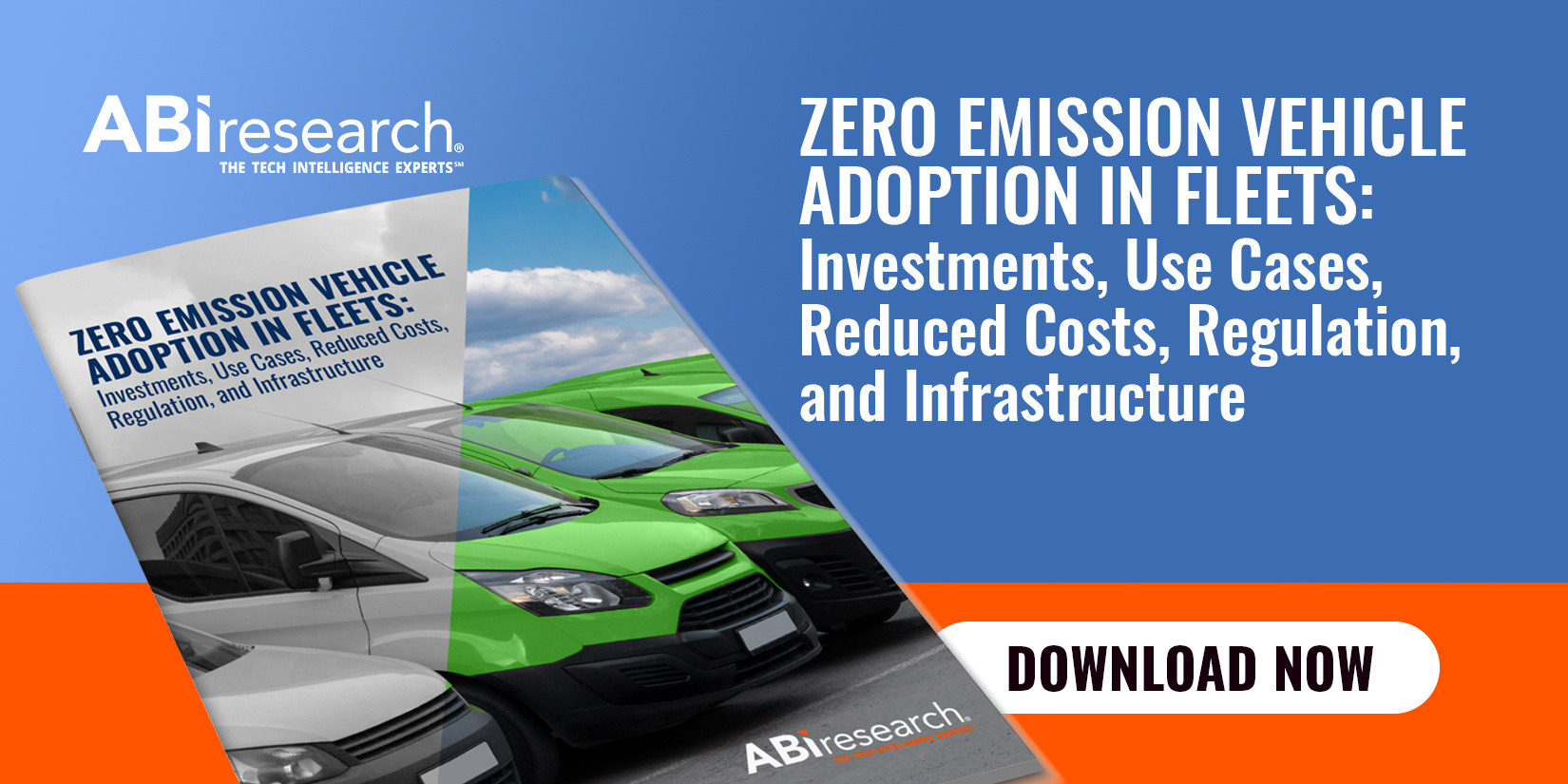When ABI Research surveyed 1,800 fleet operators last year, the results indicated that 6 out of 10 businesses place fleet electrification as their near-term goal. Consequently, the number of commercial Electric Vehicles (EVs) on the road is forecast to grow from 171,000 in 2020 to approximately 3 million by the decade’s end. Today’s rapid transition to electrified fleets and Zero-Emissions Vehicles (ZEVs) is the result of several internal and external factors. This post covers six of the biggest market drivers for fleet electrification.

1. EV Affordability
As battery costs have dropped and economies of scale have kicked in, EV trucks are more affordable for commercial fleets. Battery technology has advanced, helping decrease the price of lithium-ion battery prices by 85% since 2010. This trend, which will only continue, makes it easier for vehicle manufacturers to achieve economies of scale in their production processes and sell their EV trucks at a lower Manufacturer’s Suggested Retail Price (MSRP).
Another factor causing higher demand for EVs in fleet management is that the Total Cost of Ownership (TCO) for EV fleets is now lower than gasoline or diesel equivalents. Helping matters further, truck maintenance costs for EVs are relatively cheaper because electricity is cheaper than diesel fuel.
See how the average price for lithium-ion batteries has decreased since 2020 by viewing this interactive chart.
2. Increased Range for EVs
Historically, range anxiety has made people hesitant about electrification, but technological advancements have addressed this common concern. Lithium-ion batteries, which have broad use in EVs, are more energy-dense than ever, enabling higher-power capacity and, therefore, longer distances traveled on a single charge. Additionally, commercial EV manufacturers have made great strides in energy efficiency/decarbonization for their vehicles, increasing driving range.
These improvements in EV driving range enable long-haul trucking fleets to operate hundreds of miles on a single charge. This is a significant upgrade compared to when EV fleets had to stop frequently to charge up—hindering operational efficiency. For insight into the charging considerations commercial fleets must make, read our blog Planning for Fleet Electrification: Four Tips from an EV Research Consultant.
3. Favorable Regulations
Zero-emission fleet vehicle adoption has been spurred by a diverse set of government mandates and regulatory incentives for businesses to adopt EVs and hybrid vehicles. Initiatives include tax incentives, purchase subsidiaries, and Internal Combustion Engine (ICE) vehicle restrictions. As sustainable transportation is further advocated, even more regulatory initiatives are expected to incentivize businesses to electrify their commercial fleets. From California’s Hybrid and Zero-Emission Truck and Bus Voucher Incentive Project (HVIP) to the European Union’s (EU) Eurovignette green trucking directive, examples of initiatives for commercial EV fleets abound worldwide.
4. Government Fleets Going Green
Another significant driver for fleet electrification is the increasing adoption of EVs for government fleets. For example, the United States plans to electrify 50% of its government vehicle fleet by 2030 and invest billions of dollars in improving EV charging infrastructure. The United States Postal Service (USPS) is a great example, being committed to making all of its new delivery truck fleet vehicles electric from 2026 through 2028. The first batch of EVs for the USPS was bought in early 2023.
5. Sustainability Pressures
A recent survey from Smurfit Kappa revealed that 61% of consumers expect companies to have transparent sustainability practices. Driven by demand from eco-conscious customers and board-level sustainability mandates, supply chain stakeholders, such as fleet managers, are increasingly adopting EVs and ZEVs for transporting goods.
Amazon, DHL, UPS, and other commercial fleets realize that electrification not only cuts operational costs and generates financial incentives, but also aligns their brand values with climate activism. When many consumers hear about these green modes of transportation, they are more inclined to purchase from those companies.
6. Electrification in Mobility-as-a-Service
Given its inherently sustainable values, there’s massive interest in emissions reduction in the Mobility-as-a-Service (MaaS) industry. This spurs growing investment in fleet electrification in this space. Uber, for example, has promised that its entire ride-sharing fleet in U.S., Canadian, and European cities will consist of ZEVs by 2030. Uber’s fleet is expected to be fully electric by 2040. Moreover, scooter and bike-sharing company Lime plans to fully electrify its fleet by 2030. Lime’s electric scooters and bikes are already available in select cities.
Furthermore, car and truck rental providers, such as Ryder, Enterprise Rent-A-Car, National Car Rental, Alamo Rent a Car, and the Hertz Green Collection, are taking steps to electrify their fleets. These steps include mass purchasing of EVs and hybrid vehicles, as well as building out reliable charging infrastructure and equipping their electric trucks with fleet telematics systems.
Roadblocks to More Widespread Fleet Electrification
Major trucking manufacturers, such as Tesla, Daimler, Volvo, Navistar, Rivian, and more, are actively rolling out new EV and ZEV models for commercial fleets. Moreover, truck manufacturers like Toyota and Hyundai have also been busy in recent years producing ZEVs. These fleet vehicle developments will only continue as infrastructure and hydrogen fueling continues to develop.
While several EV market drivers paint a rosy picture for the future of fleet electrification, there are also some roadblocks in the way, such as the following:
- Upfront purchase prices
- Infrastructure cost considerations
- Lack of EV charging infrastructure
- Inadequate charging speed
To learn more about the market drivers and inhibitors for fleet electrification, as well as how fleet operators and solution providers should act now, download ABI Research’s report: Zero-Emission Vehicle Adoption in Fleets: Investments, Use Cases, Reduced Costs, Regulations, and Infrastructure. This content is part of the company’s Electric Vehicles and Supply Chain Management & Logistics research services.



